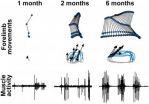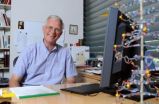In findings being presented at the annual meeting of the Society for Neuroscience in San Diego on November 14, the researchers say that the five scattered regions in the brain that make up the default-mode network (DMN) have not started working in concert in youngsters aged six to nine. These areas light up in an fMRI scan, but not simultaneously.
The DMN is only active when the mind is at rest and allowed to wander or daydream. This network is believed to be key in how a person introspectively understands themselves and others, and forms beliefs, intentions, and desires through autobiographical memory.
By ages 10 to 12, the researchers found that these diffuse regions start functioning together as a unit, and at ages 13 to19, they acted in concert, just like they do in adults.
"These results suggest that children develop introspection over time as their brains develop," says the study's first author, neuroscientist Stuart Washington, Ph.D., who will be presenting the results. "Before then they are somewhat egocentric, which is not to mean that they are negatively self-centered, but they think that everyone views the world in the same way they do. They lack perspective in that way."
In this study, the researchers sought to understand if connectivity between distant regions in the brain increases with age. They chose the DMN to study in part because it consists of a widespread system of neuronal nodes that work together, but are linked in a way that is not yet well understood. (These discrete nodes could be physically connected by neuronal synapses or they could fire together and not be connected.)
Previous research has suggested that the DMN is not well synchronized in many autistic individuals, and this may explain the perceptions many of these individuals express in testing – a viewpoint that is also seen in younger children who do not have autism, Washington says.
An example that illustrates the difference between an egocentric and an introspective view is the simple puzzle, Washington says: "Jane" walks into a room, and puts a marble in a closet, and then "Bill" comes in and takes the marble out of the closet and puts it into a box. Jane comes back in and looks for the marble and she has not spoken to Bill. Where does she look for the marble?
The right answer, of course, is that she looks in the closet. But many autistic individuals say Jane looks in the box, "because they know that the marble is in the box and they think that everyone else knows that," Washington says. The ability to see the world from the perspective of others is called "Theory of Mind" (ToM) and certain nodes of the DMN have been associated with it. The failure to develop ToM seen in many autistics individuals and younger children may lie in asynchronous firing of the DMN, Washington says.
In this study, the research team enrolled 42 participants: 10 individuals which were aged six to 9; 12 were aged 10 to 12; 9 individuals which were aged 13 to19, and 10 were aged 22 to 27 years. The scientists' goal was to study the development of functional connectivity between the anterior and posterior nodes of DMN across the four age groups.
They gave the participants a task to perform, but the scientists were actually interested in recording brain activity that took place after the task was over, when the patients were told to rest.
In the group of children ages six to nine, the researchers saw the same kind of lack of synchronicity seen in older autistic children, Washington says.
The older participants in this study were, the more in sync the DMN functioned, reaching a plateau in adulthood, he says. Significant differences were noted between children and adolescents, and children and adults, he adds. "These increases in functional connectivity coincide with introspective mental activity that has been shown to emerge during adolescence."
###
The study was funded by the National Institute of Mental Health and the Eunice Kennedy Shriver National Institute of Child Health & Human Development.
About Georgetown University Medical Center
Georgetown University Medical Center is an internationally recognized academic medical center with a three-part mission of research, teaching and patient care (through MedStar Health). GUMC's mission is carried out with a strong emphasis on public service and a dedication to the Catholic, Jesuit principle of cura personalis -- or "care of the whole person." The Medical Center includes the School of Medicine and the School of Nursing and Health Studies, both nationally ranked, the world-renowned Georgetown Lombardi Comprehensive Cancer Center and the Biomedical Graduate Research Organization (BGRO). In fiscal year 2009-2010, GUMC accounted for 79 percent of Georgetown University's extramural research funding.
Abstract: 302.9/KKK64. Developmental changes in functional connectivity between anterior and posterior nodes of the default-mode network
*S. D. WASHINGTON1, E. M. GORDON1, J. BRAR1, L. GIRTON1, A. HAILU1, A. WOLFE1, S. WARBURTON1, J. MBWANA1, W. GAILLARD1,2, M. KALBFLEISCH3, J. W. VANMETER1;
1Georgetown Univ. Med. Ctr., WASHINGTON, DC; 2Children's Natl. Med. Ctr., Washington, DC; 3Krasnow Investigations of Developmental Learning and Behavior, Fairfax, VA
Connectivity between distant regions (or nodes) of a cortical network typically increases with age and may continue into adulthood. The default-mode network (DMN), a prominent cortical network related to Theory of Mind and other introspective mental activities, is composed of multiple nodes, including the anterior (anterior cingulate, medial, and orbital prefrontal cortices) and posterior (posterior cingulate cortex) nodes. Since much of our knowledge of DMN is based on studies of adults or comparisons of children to adults, we chose to study the development of functional connectivity between the anterior and posterior nodes of DMN across 4 age groups: children (n = 10, 6-9 years, 90% male, 90% right handed, IQ = 126.60±10.62), early adolescents (n = 12, 10-12 years, 67% male, 100% right handed, IQ = 120.08±10.54), late adolescents (n = 9, 13-19 years, 67% male, 90% right handed, IQ = 117.22±13.03), and adults (n = 10, 22-27 years, 70% male, 90% right handed, IQ = 122.20±9.57). We used independent components analyses of rest scans to discern blood oxygenation level dependent (BOLD) activity related to DMN across the entire population and made regions-of-interest (ROIs) based on the anterior and posterior nodes. Correlations in BOLD activity (Fisher's z) between ROIs revealed that functional connectivity between the anterior and posterior nodes changes significantly with age (F [3, 37] = 2.99, p < 0.05). Functional connectivity monotonically increased with age during development from childhood (0.35±0.23), to early adolescence (0.53±0.16), and through late adolescence (0.63±0.31) before it plateaued in adulthood (0.63±0.22). Specifically, significant differences emerged between children and late adolescents (p=0.04) as well as children and adults (p=0.01). We conclude that synchronized BOLD activity between distant DMN nodes increases with age until late adolescence, and these increases in functional connectivity coincide with introspective mental activity that has been shown to emerge during adolescence (Remschmidt, 1994).

